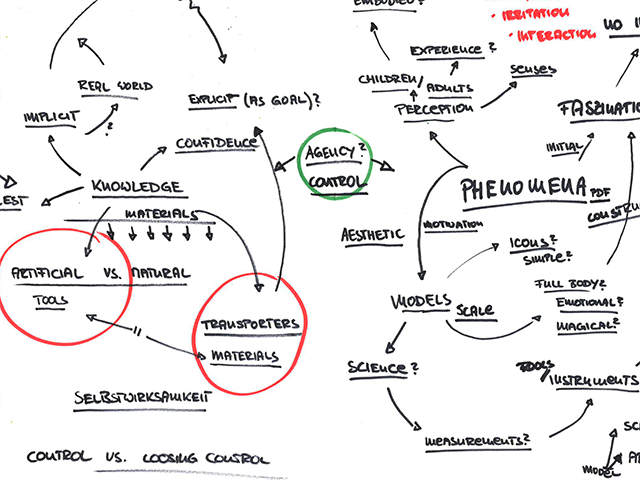We have had our first ZHdK brainstorming session on the topic and understanding of science toys. Katharina and Kevin were presenting their thoughts and ideas regarding Natural Phenomena and Knowledge as they researched it for the theory part of their Bachelor Thesis.
What is a natural phenomenon?
Katharina made some nice statements about what a phenomenon is and how it is manifested in different ways, which brought us to a discussion about phenomena and their basic qualities. Basically a natural phenomenon is perceived as a magical or fascinating moment which evokes curiosity in the observer. This curiosity is the driving force for investigating the phenomenon further and finding explanations or principles behind it. Therefore it it crucial where and how the phenomenon is presented the first time. The most prominent place where we could experiences natural phenomena is obviously nature itself. Being inside or watching a thunderstorm, feeling the power of the wind and seeing the blizzards, is a very impressive and sometimes frightening moment.
A natural phenomenon is an observable event which is not man-made.
The full immersion and excitement of all senses is something that is hard to achieve in artificial environments – like a museum. The advantage of the natural environment is, that it is not limited to one specific perspective but offers a whole variety of different points of view. Points of view is not meant literally here – of course we can see, hear, feel, smell the thunderstorm. In this way the clear perception of a phenomena in nature is also a question about being able to focus attention to a certain aspect of perception – i.e. looking really carefully how the clouds are formed. This is something that could be trained and used to really find the fascination and beauty of an natural event. In the thunderstorm that could be the initial moment where one can see the clouds becoming denser and the wind rising…
How about phenomena presented through a science toy?
The simultaneous occurring of phenomena in nature could be distracting and it is sometimes not easy to focus only on one certain phenomenon to examine it further. Therefore we could say, that science toys should help to direct the attention of people to specific phenomenon.
Which aspects of a phenomenon are worth it to be presented in a science toy?
With the use of a science toys we could furthermore extract a certain aspect of a phenomenon, guiding attention to an even smaller principle. Knowing that we could say, that by extracting we are simplifying a phenomenon – reducing it for example to one sensation. It means that we are creating a kind of model which could help to understand the phenomenon. The decision for a specific aspect and how this aspect is presented is therefore the crucial part in designing a “powerful” science toy.
What about curiosity?
As stated above curiosity is a strong driving force for steering the attention of people to a certain phenomenon. Only if I am curious about why, how and when something happens, I will investigate further with the goal to find explanations or principles which I can transfer to other similar phenomena or even better extrapolate to a completely different/new context. How can we evoke curiosity in people and keep their motivation and attention will be also an important topic for further investigation.
How can we evoke curiosity in people and keep their motivation and attention ?
Wikipedia describes curiosity as “… a sensation of uncertainty in the brain, a sensation perceived to be unpleasant. Curiosity acts as a means in which to dispel this uncertainty. By exhibiting curious and exploratory behavior, organisms are able to learn more about the novel stimulus and thus reduce the state of uncertainty in the brain.”
Here is the PDF from the Brainstorm: Brainstorm_01
